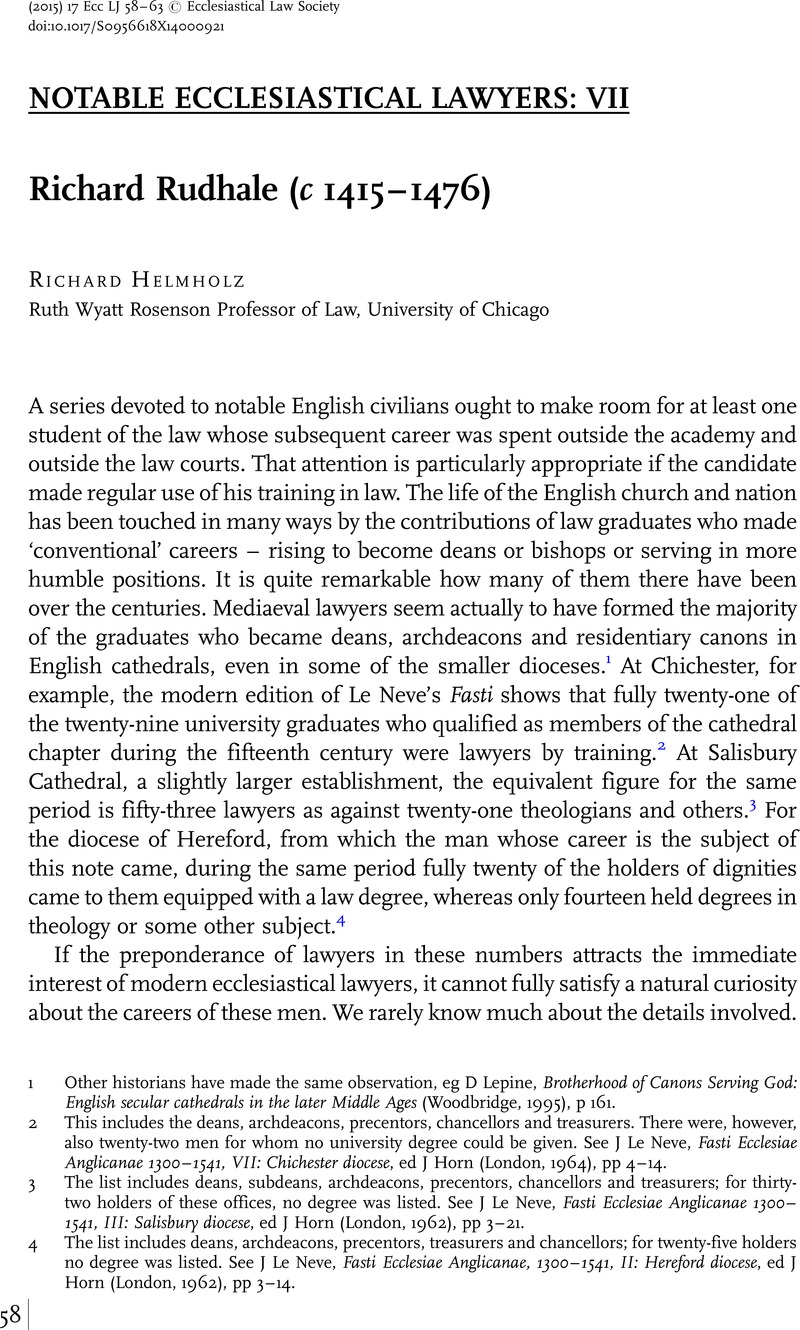No CrossRef data available.
Published online by Cambridge University Press: 11 December 2014

1 Other historians have made the same observation, eg Lepine, D, Brotherhood of Canons Serving God: English secular cathedrals in the later Middle Ages (Woodbridge, 1995), p 161Google Scholar.
2 This includes the deans, archdeacons, precentors, chancellors and treasurers. There were, however, also twenty-two men for whom no university degree could be given. See Le Neve, J, Fasti Ecclesiae Anglicanae 1300–1541, VII: Chichester diocese, ed Horn, J (London, 1964), pp 4–14Google Scholar.
3 The list includes deans, subdeans, archdeacons, precentors, chancellors and treasurers; for thirty-two holders of these offices, no degree was listed. See Neve, J Le, Fasti Ecclesiae Anglicanae 1300–1541, III: Salisbury diocese, ed Horn, J (London, 1962), pp 3–21Google Scholar.
4 The list includes deans, archdeacons, precentors, treasurers and chancellors; for twenty-five holders no degree was listed. See Neve, J Le, Fasti Ecclesiae Anglicanae, 1300–1541, II: Hereford diocese, ed Horn, J (London, 1962), pp 3–14Google Scholar.
5 Edwards, K, English Secular Cathedrals in the Middle Ages (Manchester, 1967), pp 322–325Google Scholar.
6 Bannister, A (ed), Registrum Thome Spofford, episcopi Herefordensis, A.D. MCCCCXXII–MCCCCXLVIII, Canterbury and York Society 23 (London, 1919), p 317Google Scholar.
7 For information on Rudhale's offices and benefices, see Emden, A, Biographical Register of the University of Oxford to A.D. 1500 (Oxford 1959), III, p 1603Google Scholar. Fundamental for his work in the diocese of Hereford is Lepine, D, ‘“A long way from university”: cathedral canons and learning at Hereford in the fifteenth century’ in Barron, C and Stratford, J (eds), The Church and Learning in Later Medieval Society: essays in honour of R. B. Dobson (Donington, Lincs, 2002), pp 178–209 at pp 191–195Google Scholar.
8 See Emanuel, H, ‘Notaries public and their marks recorded in the archives of the Dean and Chapter of Hereford’, (1953) 8 National Library of Wales Journal 147–162, at 162Google Scholar.
9 See generally Woolfson, J, Padua and the Tudors: English students in Italy, 1485–1603 (Toronto, 1998), pp 10–38CrossRefGoogle Scholar; Mitchell, R, ‘English students at Padua, 1460–75’, (1936) 8 Transactions of the Royal Historical Society 4th series, 101–117CrossRefGoogle Scholar, at 117.
10 Zonto, G and Brotto, J (eds), Acta graduum academicorum Gymnasii Patavini (Padua, 1969–2008), I, pt 2, pp 1626–1627Google Scholar (nos 143–144). His name does not appear, however, among the English students noted in Andrich, G, De natione Anglica et Scota iuristarum Universitatis Patvinae ab anno MCCXXII (Padua, 1892)Google Scholar.
11 Le Neve, Fasti Ecclesiae Anglicanae 1300–1541, II: Hereford diocese, pp 6 and 11.
12 See Edwards, English Secular Cathedrals in the Middle Ages, pp 39–49.
13 See Calendar of Entries in the Papal Registers Relating to Great Britain and Ireland, Papal Letters (London, 1893–1960)Google Scholar, X, p 361 and XI, pp 367 and 681.
14 Eg Bannister, A (ed), Registrum Johannis Stanbury, episcopi Herefordensis, A.D. MCCCCLIII–MCCCCLXXIV, Canterbury and York Society 25 (London, 1919), pp 71–82Google Scholar (canonical elections); ibid, pp 127–131 (heresy); idem (ed), Registrum Thome Millyng, episcopi Herefordensis, A.D. MCCCCLXXIV–MCCCCLXCII, Canterbury and York Society 26 (1920), pp 14–16 (compurgation)Google Scholar.
15 Heseltine, P and Stuchfield, H, Monumental Brasses of Hereford Cathedral (London, 2005), pp 22–23Google Scholar. A picture of the brass is found in Swanson, R and Lepine, D, ‘The later Middle Ages, 1268–1535’ in Aylmer, G and Tiller, J (eds), Hereford Cathedral: a history (London and Rio Grande, OH, 2000), p 66Google Scholar. The text is given in Winnington-Ingram, A, Monumental Brasses in Hereford Cathedral (third edition, Hereford, 1972), pp 8Google Scholar, 17.
16 Mynors, R and Thomson, R, Catalogue of the Manuscripts of Hereford Cathedral Library (Woodbridge, 1993), p xxiiiGoogle Scholar. References to the manuscripts are given herein by the letters and numbers found in this Catalogue.
17 P.V.14; its ownership from 1271 to Rudhale's purchase is traced in Mynors and Thomson, Catalogue of the Manuscripts of Hereford Cathedral Library, p 102.
18 Maitland, F, ‘Introduction’ in Maitland, F (ed), Select Passages from the Works of Bracton and Azo, Selden Society 8 (London, 1895), pp ix–xGoogle Scholar; Güterbock, K, Bracton and his Relation to the Roman Law, (Philadelphia, PA, 1894), pp 51–55Google Scholar.
19 O.IX.4.
20 Van Hove, A, Prolegomena ad Codicem iuris canonici (Mechelen, 1945), p 521Google Scholar.
21 I have sought to describe briefly the contemporary place of such works in the introduction to Helmholz, R (ed), Three Civilian Notebooks 1580–1640, Selden Society 127 (London, 2010), pp xlix–lGoogle Scholar.
22 P.VI.7, fo 87v: ‘Nota rex Francie non subiicitur imperatori. Idem de rege Anglie ut notat Host[iensis]’ (a reference to X 4.17.13).
23 P.VIII.10, fo 131: ‘pro iure archidiaconali’ (discussion of X 2.26.15, dealing with the establishment of prescriptive rights).
24 P.VIII.10, fo 51: ‘Pro hac glossa nota bene Arch’, xii d, c illud (Dist 12, c 4).
25 O.IX.4, fo 173v: ‘Nota pro Mauricio de Wynter contra Symondes’.
26 P.VIII.10, fo 113v: ‘Contra Pede’ (referring to X 2.20.37). There is a similar annotation in O.VII.5, fo 51v: ‘Nota contra Pede’.
27 O.VII.5, fo 139v: ‘Contra Mag. Grene et pro Ricardo Rudhale’.
28 O.VIII.7, fo 50: ‘Nota contra opinionem domini Rotherham’.
29 P.VIII.10, fos 14v, 18: ‘Nota absolutio tenet iniusta ut hic … et melius ff. De precario l. fi.’ (Dig 43.26.22).